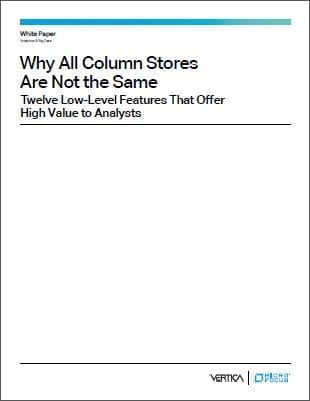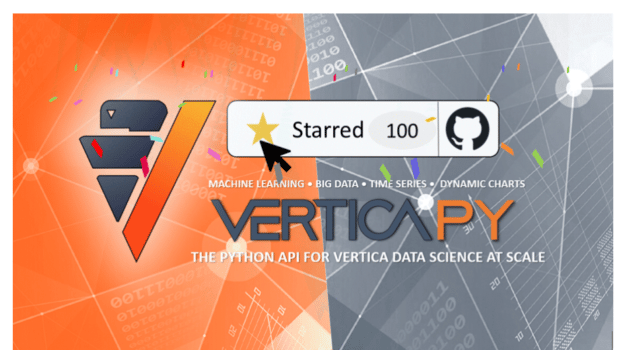See More Industry Trends Posts
View All Vertica Blog Posts
OpenText Welcomes Micro Focus Customers, Partners, and Employees
Jeff Healey, Vice President of Marketing, Vertica Product Group in Micro Focus
January 31, 2023
OpenText CEO and CTO Mark Barrenechea blogs on how the Micro Focus acquisition expands OpenText's mission to help enterprise professionals secure their operations, gain more insight into their information, and better manage an increasingly hybrid and complex digital fabric. Read his article here.
GigaOm Radar for Data Warehouses Recognizes Vertica as Leader
Jeff Healey, Vice President of Marketing, Vertica Product Group in Micro Focus
January 17, 2023
With the excitement in our industry regarding the emergence of data lakehouses, there’s a good chance that you are planning to modernize or even “replatform” your incumbent data warehouse to meet an ever-evolving variety of analytical use cases. Many vendors, like Vertica, have transformed the original concept of data warehouses with groundbreaking innovations like massively...
VerticaPy reaches a milestone at 100 stars
Mike Perrow, Senior Product Marketing Writer/Editor
December 14, 2022
The Vertica team is happy to share a milestone in our “VerticaPy journey”: We just reached 100 stars in our GitHub repo, and it’s growing every day. (Repo: That’s “repository” for those of you unfamiliar with GitHub.) Repos accumulate stars as an indication of user interest – think of them as bookmarks in a user’s...
Announcing the Availability of Vertica JavaScript Driver (vertica-nodejs)
Amrita Akshay, Information Developer
September 30, 2022
This post is authored by Bill Jones and Danny Mickens. What is Node.js? Wikipedia defines Node.js as an “open-source, cross-platform, back-end JavaScript runtime environment that runs on the V8 engine and executes JavaScript code outside a web browser, which was designed to build scalable network applications”. Consequently, Node.js represents a "JavaScript everywhere" paradigm, unifying web-application...

 The fact is, it’s pretty hard to develop a columnar database, particularly one that is pushed as hard as Vertica clients push us. The Vertica team has been at this for nine major releases now, writing Vertica from scratch to make the most of the columnar approach. Unlike other solutions, we are not attempting to take a row store engine and use it to store data in columns because we know that there would be limited value in doing so. We are not using columnar storage for archiving since we believe columnar storage is the fastest and most efficient way to access stored data for many kinds of analytics. Others believe that it’s only for information lifecycle management and archiving old data. We know that columnar storage both provides opportunities for incredible performance while also presenting certain challenges. Overcoming these challenges and exploiting the opportunity has been all we’ve thought about for more than a decade.
Columnar databases are not a commodity, yet I see the major analysts firms saying this is so. If you get caught up in thinking that Oracle, for example, can do column store with the same efficiency, performance and concurrency as Vertica I think you can be lead into making very bad decisions about your analytics. Even for databases that are true column stores, you are possibly facing some sort of major technical flaw, including single point of failure, memory management limitations, lack of analytics workload management to support concurrency and more.
If you really need to put big data analytics into production, there is no better solution than a columnar database, but please don’t believe for a second that they are all the same. Be better than the major analysts firms and take a look under the hood before you update your data warehouse or tackle your big data challenges.
The fact is, it’s pretty hard to develop a columnar database, particularly one that is pushed as hard as Vertica clients push us. The Vertica team has been at this for nine major releases now, writing Vertica from scratch to make the most of the columnar approach. Unlike other solutions, we are not attempting to take a row store engine and use it to store data in columns because we know that there would be limited value in doing so. We are not using columnar storage for archiving since we believe columnar storage is the fastest and most efficient way to access stored data for many kinds of analytics. Others believe that it’s only for information lifecycle management and archiving old data. We know that columnar storage both provides opportunities for incredible performance while also presenting certain challenges. Overcoming these challenges and exploiting the opportunity has been all we’ve thought about for more than a decade.
Columnar databases are not a commodity, yet I see the major analysts firms saying this is so. If you get caught up in thinking that Oracle, for example, can do column store with the same efficiency, performance and concurrency as Vertica I think you can be lead into making very bad decisions about your analytics. Even for databases that are true column stores, you are possibly facing some sort of major technical flaw, including single point of failure, memory management limitations, lack of analytics workload management to support concurrency and more.
If you really need to put big data analytics into production, there is no better solution than a columnar database, but please don’t believe for a second that they are all the same. Be better than the major analysts firms and take a look under the hood before you update your data warehouse or tackle your big data challenges.






